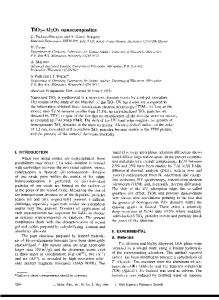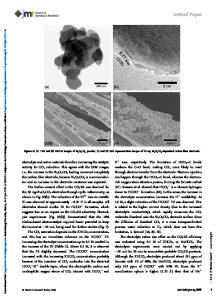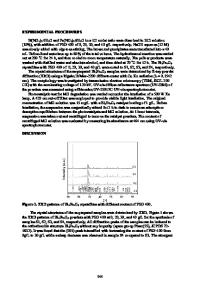Enhanced photocatalytic activities on Bi 2 O 2 CO 3 /ZnWO 4 nanocomposites
- PDF / 530,939 Bytes
- 8 Pages / 584.957 x 782.986 pts Page_size
- 7 Downloads / 297 Views
Bi2O2CO3/ZnWO4 composite photocatalysts have been successfully synthesized by a mixed calcination method after hydrothermal process. The catalysts were characterized by powder x-ray diffraction, scanning electron microscopy, transmission electron microscopy, high resolution transmission electron microscopy, x-ray photoelectron spectroscopy, and UV-vis diffuse reflectance spectrum. The results showed that the hierarchical Bi2O2CO3/ZnWO4 nanocomposites were obtained by mixed grinding calcination method and Bi2O2CO3 nanospheres grow on the primary ZnWO4 particles. The Bi2O2CO3/ZnWO4 composites exhibit higher photocatalytic activities compared to pure ZnWO4 and Bi2O2CO3 particles under UV light irradiation. Furthermore, the excellent photocatalytic efficiency of the Bi2O2CO3/ZnWO4 composite was deduced closely related to Bi2O2CO3/ZnWO4 heterojunctions whose presence is generally regarded to be a favorable factor for the separation of photogenerated electrons and holes.
I. INTRODUCTION
Photocatalytic degradation of organic pollutants by semiconductor photocatalysts has a great potential to be a beneficial technology to protect our environment. TiO2, WO3, ZnO, and their complex are commonly used as semiconductor oxide photocatalytic materials.1–4 With further study, researchers continue developing new photocatalytic materials, such as layered, tunnel, molecular sieve photocatalysts and assembled nano-semiconductor photocatalytic materials. In recent years, the metal tungstate photocatalyst has attracted widespread interests. Among the tungstate family, ZnWO4 has been reported to be valuable for photodegradation of organic pollutants. Instead of using a single photocatalyst, the coupling with other semiconductors, metals, or molecules to form heterojunction structures has been found to be significantly benefited to enhance the photocatalytic activity.5–8 Murcia Lopez et al.9 investigated that Bi2WO6/TiO2 composite photocatalyst exhibited a higher degradation rate than that of single TiO2 because of the higher efficiency of charge carriers’ separation. Ivana et al.10 have developed a new low temperature synthesis method for preparation of ZnO/ZnWO4 rod-like particles in nanometer size under mild experimental conditions. He et al.11 reported that Bi2WO6/ZnWO4 composite exhibited a better UV light photocatalytic activity compared to individual ZnWO4 nanorods. Thus, ZnWO4 can
Address all correspondence to these authors. a) e-mail: [email protected] b) e-mail: [email protected] DOI: 10.1557/jmr.2014.29 J. Mater. Res., Vol. 29, No. 5, Mar 14, 2014
http://journals.cambridge.org
Downloaded: 13 Mar 2015
serve as a good substrate to form a composite photocatalyst. At the same time, bismuth-based photocatalysts have received a lot of attention in environmental remediation over the past few years. Among which, Bi2O2CO3,12–16 one of the layered oxide family with characteristic structures of alternative stacking of (Bi2O2)21 layers, was found to exhibit high photocatalytic activity. Cheng et al.17 first found that Bi2O2CO3 has a good effect
Data Loading...











